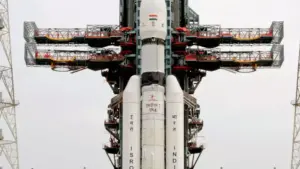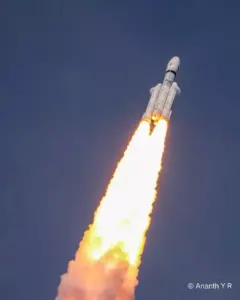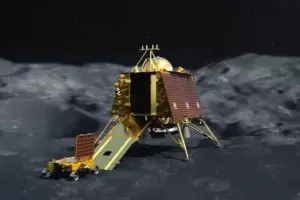
Chandrayaan 3 which means moon vehicle in Sanskrit . Chandrayaan 3 is the mission safe landing and roving on the lunar South pole surface to study about moon surface . Before the chandrayaan 3 Chandrayaan 2 and chandrayaan 1 was launched from India. Chandrayaan 3 will be launched on 14 July 2023 at 2:35 pm by LVM3 from the satish Dhawan space center in Sriharikota. chandrayaan 3 will be and at the moon’s south pole , a location, where the presence of water molecules was discovered during India’s inaugural moon mission in 2008 . India is fourth country to moon surface soft landing.
Chandrayaan 3 will be launched vehicle is Chandrayaan 3 lander name is Vikram and Rover name is pragyan (Sanskrit for Wisdom).
Chandrayaan 3 after launched aims to reach moon 1n 40 day and soft land to moon’s south pole surface at August 23 and 24 .

Exclusive discussion about chandrayaan 3
1. Chandrayaan 3 mission life time is one lunar day at (14 day of earth)
2. Chandrayaan 3 mission landing site of moon at 4 km x 2.4 km , 69,367621 S , 32.348126 E,
3. Chandrayaan 3 has some scientific payloads is
a.Radio anatomy of moon bound hypersensitive ionosphere and atmosphere (RAMBHA).
b. chandra’s surface thermo physical experiment (CHASTE).
C. Instrument for lunar seismic activity (LRA) Rover
D.Alpha particle x- ray spectromerer (APXS)
E.laser induced breakdown spectroscope (LIBS) propulsion module
F.spectro polarimetry of habitable planet Earth (SHAPE)
4. Chandrayaan 3 module configuration is
a. Propulsion module (carries lander from launch injection to lunar orbit
B.lander module (rover is accommodated inside the lander )
5. Chandrayaan 3 mass weight
a. Propulsion module 2148 kg
b.lander module 1752 kg including rover of 26 kg
c. Total is 3900 kg

6. Chandrayaan 3 has 3 power generation is
A.propulsion module:758 W
B. Lander module 738W, WS with bias
C. Rover : 50 W
7. Chandrayaan 3 has 3 communication is
A. Propulsion module communicates with IDSN
B. Lander module communicates with IDSN and Rover
C.rover communicates only with lander
8. Chandrayaan 3 lander sensors is
a. Laser inertial referencing and accelerometer package (LIRAP)
b. Ka-Band altimeter (KARA)
c. Lander position detection camera (lPDC)
d. LHDAC (lander hazard detection & avoidance camera)
e. Lasar altimeter (LASA)
f.Laser Doppler velocimeter (LDV)
g. Lander horizontal velocity camera (LHVC)
h. Micro star sensor
I. Inclinometer & touchdown sensors
9. Chandrayaan 3 actuators reaction wheels -4 nos (10 nmd & 0.1 nm )
10. Chandrayaan 3 lander propulsion system is bi-propellant propulsion system (MMH+MON3), 4 nos. Of 800 N throttle engines & 8 nos of 58 N; throttle bol Engine control Electronics
History of chandrayaan mission

India has launched two luner mission so far , the first chandrayaan mission was launched on October 22, 2008
This mission was known for its discovery of the moon and later it led to many other discoveries too.
And the second mission is Chandrayaan 2 was launched on July 22,2019 .
The lander Mane it to the luner orbit but was later lost just 2.1 km about the moon’s surface
Chandrayaan 2 mission was launched from Sriharikota space centre on 22 July 2019 to the moon byy a geo synchronous satelite launch vehicle mark (GSLV mk )
Chandrayaan 2 is an Indian lunar mission that will explore the moon’s south polar region no country has ever gone there before.
Then chandrayaan 3 is launched from Sriharikota space centre to a soft landing at moon’s south pole surface.
Chandrayaan 3 success landing

23 rd August when the Vikram lander of chandrayaan 3 was landed softly on South pole moon’s surface. After a successful landing on the south pole of the moon , raised the head of India and its residents with pride .Now India can also say that our country has reached the moon , and not jast reached but we have landed on that part of the
moon , where even America had not been able to land until today